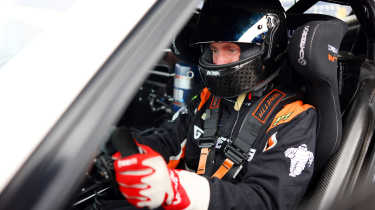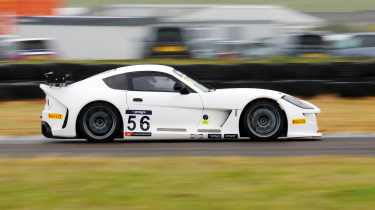Ginetta G56 GT Pro 2024 review – a finishing school for racing drivers
The Yorkshire firm’s G56 GTP is a finishing school on wheels for aspiring GT race drivers. We try it for size in the heat of competition in the Ginetta Festival
You may remember a Ginetta racing car joining evo’s Fast Fleet last summer, as staff writer Yousuf Ashraf and I competed in seven races in the Ginetta GT Academy – the Leeds firm’s entry-level racing series for adults. Those last two words wouldn’t normally be a point to clarify, but with the Ginetta Juniors championship still a step on the ladder for aspiring race drivers aged 14-17, Ginetta offers two different entry-level series.
That car was the G56 GTA. This is the next rung on the ladder: the G56 GT Pro, or GTP for short. Like the GTA, it’s a muscular front-engined GT car, with a 3.5-litre V6 driving the rear wheels and a brutishly handsome design that reminds me a little of a Dodge Viper-ish classic GT car crossed with cues from Ginetta’s other models, past and present. I like it.
> Ginetta G56 GTA review – a fabulous portal into the world of motorsport
Whereas the Academy is aimed at amateur drivers taking their first steps from trackdays into full-on motorsport as well as more experienced drivers, the GTP is designed for those looking to go further and progress into the higher echelons of GT racing. It costs £99,000 plus VAT compared with the GTA’s £85,000 plus VAT, and has its own separate one-make series: the Ginetta GT Championship, which has taken the place of the Ginetta Supercup as the brand’s headline championship.
More reviews
Group tests
- Alpine A290 v Alpine A110 – how much DNA do they really share?
- Ariel Atom 4R v Caterham Seven ‘evo25’: power-to-weight heroes go head-to-head
- Caterham Super Seven 600 v Super Seven 2000
- Levante v T1
- Corvette Stingray v Porsche Cayman GTS v Audi R8 RWD
- Great Ferrari hypercars driven: 288 GTO, F40, F50 and Enzo head-to-head
- Hardcore Ferrari V8 specials go head-to-head
- Lamborghini Aventador Ultimae v Lamborghini Countach
- Lotus Emira v Morgan Plus Four – four-cylinder Brits go head-to-head
- Toyota GR86 v BBR Mazda MX-5: supercharged drop-top battles sports coupe
In-depth reviews
- Abarth 600e 2025 review – Italy gives the Alpine A290 something to worry about
- Alpine A110 review – distinctive, lightweight and unforgettable to drive
- Audi R8 (2015 - 2024) review – the ultimate soft-focus supercar
- Bentley Continental R Mulliner: review, history and specs
- BMW 5-series review – is this still Munich’s anchor model?
- BMW 1-series review – Munich’s Audi A3 rival gains focus
Long term tests
- Abarth 695C Turismo Fast Fleet test – 10,000 miles in the Italian hot hatch
- Alfa Romeo Giulia Veloce Fast Fleet test – 7000 miles in the sharp Italian saloon
- Alpina B10: end of term report
- Alpina B10
- Ford Mustang GT
- Ford Mustang GT
- Ford Mustang GT
- Land Rover Defender 110 Fast Fleet test – 9000 miles in the go-anywhere SUV
- Maserati Ghibli Trofeo Fast Fleet test – 4000 miles in the Ferrari-powered saloon
- Mitsubishi Evo MR 340
Review
- New Aston Martin DBS 770 Ultimate review – 759bhp super-GT driven
- New Bentley Batur 2023 review – can it possibly be worth £1.65m?
- 2023 Chevrolet Corvette C8 Z06 review – the American 911 GT3?
- Kia EV6 GT-Line S prototype review – the EV that shows how it’s done
- BBR Supercharged Mazda MX-5 (ND) 2023 review – tuned 250bhp roadster driven
- MG4 Trophy 2023 review
Reviews
- Abarth 695 75 Anniversario edition 2024 review – a fitting send-off for Abarth’s hot supermini?
- Abarth 500e 2023 review
- AC Cobra 378 Superblower MkIV 2021 review – another V8 Cobra, but with a GM heart this time
- Acura Integra Type S 2024 review – a Honda Civic Type R with added restraint
- Alfa Romeo Giulia 2025 review – get one while you still can
- Alfa Romeo SZ: history, review and specs of an icon
- Alfa Romeo 1750 TBi
- Alpina B3 GT Touring 2025 review – a 190mph alternative to the BMW M3 Touring
To that end, the GTP has more power and more downforce than the GTA and runs on GT3-spec slick tyres rather than the road-legal treaded tyres Academy drivers race on in the dry. Among the other upgrades are bigger brakes, and it also runs traction control and ABS, because those systems are de rigueur in GT3 and GT4 classes in international GT racing, so if drivers are to graduate, it’s best they learn to use the tools to their advantage. ‘Using the ABS effectively can gain you as much as six to eight tenths of a second a lap,’ says motorsport director and factory driver Mike Simpson. ‘You’ve got to learn how to come off the brake pedal as the ABS is triggered; we’ve put lights on the driver display so they can see when the ABS is engaged, and modulate their pressure on the pedal.’
Limbo your way through the roll-cage and into the (very comfortable) driver’s seat and you’ll find yourself sitting behind a cut-down steering wheel with day-glo switches and the aforementioned configurable digital display. So far, so similar to the G56 GTA, but look to the right and the centre console has gained two twist-dials, for the traction control and ABS, motorsport-specific systems developed by Bosch. There are nine stages for the TC and 12 for the ABS (12 being off completely). I’ll be leaving it on.
The Ford-sourced, Ginetta-fettled V6 fires into a loud but smooth idle. It’s running 300bhp compared with the GTA’s 270bhp, and sits under a different bonnet, with additional carbonfibre louvres and a wider-gobbed intake for improved breathing and cooling. There’s a six-speed Quaife racing sequential gearbox and limited-slip differential, but it’s not a transaxle set-up – that’s saved for Ginetta’s GT4 car. Gearshifts are actuated by paddles, not a lever, you press a button for neutral, and there are three pedals – you use the clutch pedal to set off then don’t need to touch it again once you’re moving. You can make flat upshifts and there’s an auto-blip on downshifts.
Although the GTP has more downforce than the GTA it still does without a big front splitter. Instead there’s a smaller splitter-type lip moulded into the front bumper. The resulting aero allows cars to follow each other as closely as possible without losing front downforce and gives predictable handling in fast corners. Suspension is double wishbones all round, and highly adjustable, as you’d expect of a race car.
We’re testing the G56 GTP at Anglesey, home of evo’s lap time leaderboard (although we’re driving the Ginetta on the longest International GP layout, so can’t compare directly with cars we’ve timed in the past). Contrasting with the road-legal cars we ordinarily test here, the GTP’s limits are dramatically higher. The scarily fast Church curve, which is normally a touch-and-go game of dare in a road-legal supercar, is a different corner entirely in the Ginetta: rather than braking before it as you would in most road cars, in the GTP you actually enter with the throttle pinned to the floor, lifting shortly before the apex to pivot the car toward the inside kerb, then getting back on the power as early as you dare.
The other part of the track that usually gives me nightmares, the near-blind uphill entry to Rocket In, where you’re braking from the fastest point on the track while trying to haul the car over to the right-hand side, is an entirely different ball game. With so much grip and stability, you can place the G56 almost wherever you want, even when the car is heavily loaded by cornering forces, and with the security of the ABS to lean on it’s much easier to get the car stopped without running wide.
As Simpson explains, however, there is definitely a skill to using the system to its full advantage: rather than hoofing the brake pedal and hoping for the best, you need to blend smoothly off the pedal as you see the lights flash and feel the system at work, almost as you would in a car without anti-lock. It’s far from easy to master, and I sense it would take time to fully get to grips with its potential.
Happily we have a little more time to work on it, since Ginetta believes its cars are best experienced in the environment they were designed for: racing. Therefore, we will line up on the grid for a four-race round of the Ginetta GT Championship. This is not going to be your usual first-drive report.
The championship is split into two classes, based broadly on driver age and experience: Pro and Am. We’ll be competing in the Am class. My first track time is dry, with the peaks of Snowdonia visible across the Menai Strait and the Irish Sea glittering prettily in the sunlight, but qualifying is against a backdrop of dingy grey, in steady rain. The G56 GTP turns out to be just as predictable in the wet as in the dry, its 50:50 weight distribution and tractable power delivery making it a trustworthy car to drive. Being able to adjust the ABS and traction control to suit the conditions helps enormously, too.
The rain is falling more heavily as we take the rolling start for Race One and the second race will remain equally soggy. Throughout both wet races the G56 GTP proves to be as intuitive and manageable to race in a pack of cars and the heat of battle as it is on an empty circuit. Since the car is so user-friendly to drive, you’re able to concentrate on the business of instinctive racing, attacking and defending, without worrying that the car is going to bite you. The only downside, compared to a racer based on a mass-production car, is iffy ventilation; although there is air-con, for both racing in hot climates, and demisting in the rain, the windscreen has a habit of misting up. Pro tip: the trick some race teams use to get around this is to spread a thin layer of Fairy Liquid on the inside of the screen.
Somehow I come away from both wet races with an Am class podium in each, and second place overall in the second race. That says more about the G56 GTP’s accessibility than it does about my ability. It’s a much easier car to drive than its assistance-free GTA sibling, which is something of an irony given that’s a car aimed at less experienced drivers; but if learning to use the electronic systems is key to progressing, the GTP is a great classroom.
Two more class podiums follow in the final two races, this time in the dry. As good as the GTP was in the wet, it’s a delight to be able to push it on a clear, rain-free track again, feeling the tyres dig in and revelling in the extra grip. Anglesey is a seriously abrasive track, and tyre management is important; so is altering the car’s set-up through the weekend to account for tyre wear. The Pirelli slick tyre is the same for everyone, and the same compound and construction as that used in international GT3 racing. ‘After a season’s racing, you’re well prepared,’ Mike Simpson says. ‘You know how to bring them in from cold, how to make set-up changes to manage the tyre; it’s another level of education.’
Next year the G56 GTP will be replaced by an updated G56 GTP8 model, with 6.2-litre V8 power, a transaxle layout and the potential to be upgraded into a full GT4‑spec car, eligible for international competitions. Ginetta is offering a part-exchange deal to buy the existing cars back and, at time of writing, next year’s championship is fully subscribed with 22 cars. Perhaps less importantly, but still significantly, the G56 GTP is also truly fantastic fun to drive, and even better to race.
Ginetta G56 GT Pro specs
| Engine | V6, 3498cc |
| Power | 300bhp @ 5000rpm |
| Torque | 299lb ft @ 4000-5000rpm |
| Weight | 1130kg (270bhp/ton) |
| Tyres | Pirelli P Zero slicks |
| 0-62mph | 3.6sec (est) |
| Top speed | 150mph |
| Basic price | £99,000+VAT |
This story was first featured in evo issue 327.







